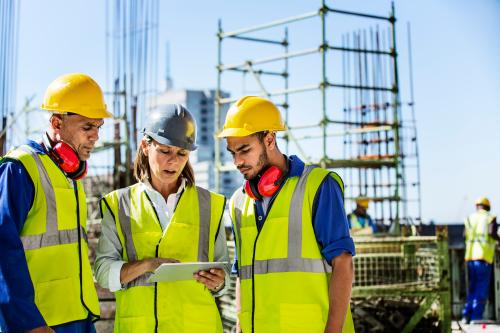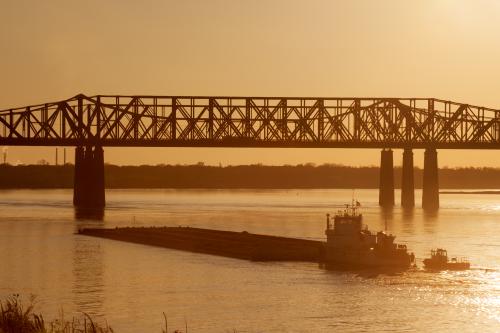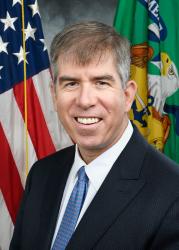This op-ed originally appeared in Real Clear Markets on June 28, 2019.
Physical infrastructure underlies all economic activity, allowing consumers, workers, and firms to coordinate to mutual advantage. Getting infrastructure decisions right is a core part of economic policy, and infrastructure has been a constant topic of conversation in Washington, D.C. for years. As policymakers consider new directions for infrastructure policy, they should have in mind the following questions: when infrastructure should be built, what type of infrastructure is needed, and how to choose and fund infrastructure projects.
For example, if infrastructure investments were better timed, they could help to minimize the damage and duration of a recession by working as effective fiscal stimulus. In the new Hamilton Project book, Recession Ready: Fiscal Policies to Stabilize the American Economy, economist Andrew Haughwout proposes an automatic infrastructure investment program that would use federal funds and local expertise to increase transportation spending during an economic downturn. This proposal would also incentivize states to develop a catalog of construction projects that the federal government would fund as soon as a recession begins. These projects could include improvements to highways, bridges, ports, and bus and rail transit, among other projects.
Regardless of the timing of infrastructure spending, efficient selection of infrastructure projects is vital. When local knowledge is brought to bear, interjurisdictional spillovers are taken into account, and cost-benefit analysis is applied, the likelihood of efficient selection is significantly increased. This, in turn, allows infrastructure projects to be as effective as possible in facilitating economic growth and other social objectives, from public health challenges to climate risk.
The lifespan of infrastructure projects can extend across generations, and choices we make today will affect where people live, how they travel, and how resilient our economy is to a changing climate. Accordingly, as policymakers consider the nation’s infrastructure needs and how best to meet them, the economic costs of climate change must be a chief concern. In a Hamilton Project proposal, economist Matthew Kahn describes infrastructure investments that would protect urban places and populations by making them more resilient to climate change and environmental threats, from severe storms to extreme heat. Kahn explains that new investments in infrastructure will be most effective if they flow to areas that face the largest climate risks and have the most difficulty in funding their own investments in resiliency.
Moreover, policies must be adjusted to encourage population and economic activity to gradually flow towards places with inherent climate resiliency advantages. Kahn proposes diagnosing the risks through the creation of a real-time database of infrastructure gaps related to climate resiliency. City governments would be encouraged to assess their risks, generating annual reports on climate challenges.
Investing in the most valuable projects will promote long-run economic growth and climate resilience, but infrastructure spending matters in the short run as well as the long run. This is evident in the important contribution that infrastructure investment makes to GDP. The investment of state and local governments—who do the bulk of infrastructure spending, even if the federal government pays for much of it via grants—makes a sizable contribution to annual GDP growth.
This matters especially during recessions, when state and local governments tend to reduce their expenditures, thereby amplifying economic downturns. Perversely, recessions are the times when infrastructure investments make the most sense: interest rates are typically low and substantial amounts of capital and labor are idle, meaning that public investments are less likely to displace private activity.
One good option to make more use of infrastructure spending as fiscal stimulus is to leverage the current BUILD (formerly TIGER) program in which states apply for infrastructure funding from the federal government. The objective, as proposed by Haughwout, would be to make BUILD funding countercyclical: during a recession, the program would automatically expand funding for state and local transportation projects, prioritizing shovel-ready plans with the potential to yield the highest returns. Funds would then shrink later in an expansion, given that in good times states are better able to fund their own projects. The proposed projects would go through rigorous cost benefit evaluation and would be insulated from political considerations, allowing for selection of the investments with the highest economic and social returns.
While project timing, evaluation, and selection are of great importance, funding and financing decisions are also critical. A combination of taxation, user fees, and traditional borrowing are usually the most appropriate choices, as they allow for a transparent accounting of infrastructure costs. These and other infrastructure policy considerations are discussed in a Hamilton Project report that focuses on the key choices confronting policymakers.
Much of our nation’s economic activity is made possible by roads and railways, parts of which were built over a century ago. Getting the decisions right regarding when we build infrastructure, what we build, and how we spend our money will affect our economy long into the future. Whether policymakers are facing the costs of climate change or cyclical economic downturns, they should consider the potential benefits of sound infrastructure investments.
The Brookings Institution is committed to quality, independence, and impact.
We are supported by a diverse array of funders. In line with our values and policies, each Brookings publication represents the sole views of its author(s).









Commentary
Op-edWise infrastructure investments can stabilize the economy and reduce climate risk
July 2, 2019